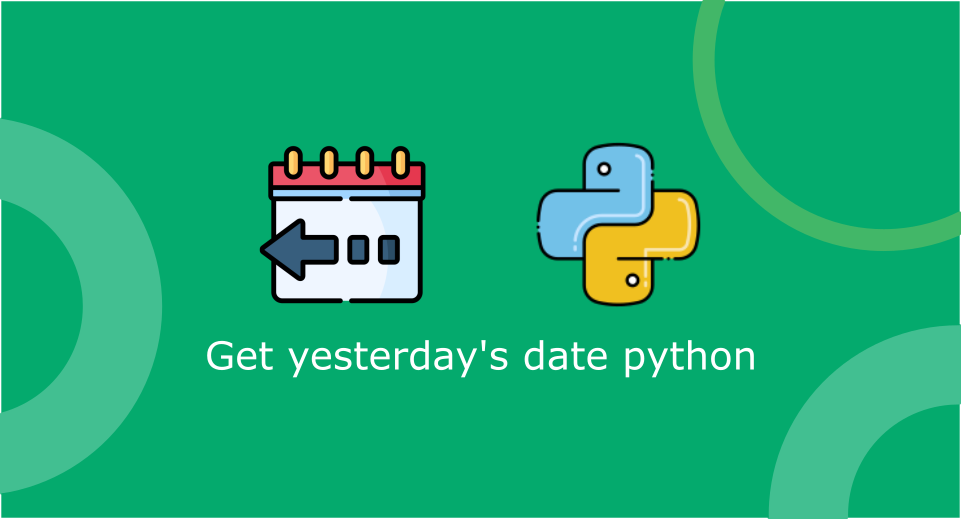In This Article
A step-by-step tutorial on “Python get yesterday date“. Have you ever needed to get yesterday’s date in Python for your programming project or application?
Whether you’re working on a data processing script or building a web application, handling dates is a common task in programming.
In this article, we’ll walk you through how to get yesterday’s date in Python using various techniques.
How to get yesterday’s date in Python?

There is more than one way to get yesterday’s date in Python.
Explore different approaches to obtain Yesterday’s Date in Python.
Discover the below methods and choose the one that best suits your needs to effortlessly retrieve yesterday’s date in Python.
Get yesterday’s date using Python datetime Module
One way to find yesterday date in Python is by using the datetime module. This module provides classes for working with dates and times, including date, time, and datetime.
To get yesterday’s date use the datetime module. You can subtract one day from the current date using the timedelta class.
Here’s an example code:
from datetime import date, timedelta
yesterday = date.today() - timedelta(days=1)
print(yesterday)
In this code, we first import the date and timedelta classes from the datetime module in Python. We then create a yesterday Python variable by subtracting one day from today’s date using the timedelta class.
Finally, we print the value of Python yesterday’s date using the print() function.
The output of Python date yesterday is:
2023-05-03
Get Python yesterday’s date using the dateutil Library
To use the dateutil library and effortlessly retrieve yesterday’s date in Python, follow these steps:
Start by installing the dateutil library (if you haven’t already) by running the following command:
pip install python-dateutil
Then Import the necessary module in your Python script and retrieve yesterday’s date using the dateutil library.
from dateutil.relativedelta import relativedelta
from datetime import datetime
# Get the current date and time
current_date = datetime.now()
# Subtract one day using relativedelta
yesterday = current_date - relativedelta(days=1)
# Extract the date portion from the datetime object
yesterday_date = yesterday.date()
# Print the result
print("Yesterday's date:", yesterday_date)
By utilizing the relativedelta function from the dateutil library, you can easily subtract a specific number of days from the current date and obtain yesterday’s date.
The days=1 parameter in relativedelta(days=1) indicates that you want to subtract one day.
Finally, by extracting the date portion using the .date() method, you can isolate the date value without the time component.
Python get yesterday date using Arrow Library
Another way to Python get yesterday date is by using the Arrow library.
This library provides a simpler and more human-friendly interface for working with dates and times than the built-in datetime module.
To use the Arrow library in Python, First you need to install it first using pip.
You can do this by running the following command in your terminal:
pip install arrow
Once you’ve installed the Arrow library, you can use its Arrow class to get Python yesterday’s date.
Here’s an example code:
import arrow
yesterday = arrow.now().shift(days=-1).date()
print(yesterday)
In this code, we first import the arrow library. We then create a yesterday variable using the Arrow class and the shift() method to go back one day in time.
Finally, we extract the date part of yesterday’s datetime using the date() method and print it.
Output
2023-05-03
Get Python yesterday’s date using the Pendulum Library
The Pendulum library is another popular library for working with dates and times in Python.
It provides an easy-to-use and powerful interface for handling timezones and date arithmetic.
To use the Pendulum library, you need to install it first using pip.
You can do this by running the following command in your terminal:
pip install pendulum
Once you’ve installed the Pendulum library, you can use its pendulum class to get yesterday’s date.
Here’s an example code for Python yesterday’s date:
import pendulum
yesterday = pendulum.now().subtract(days=1).to_date_string()
print(yesterday)
In this code, we first import the pendulum library.
We then create a yesterday variable using the now() method to get the current date and time in the local timezone.
We then use the subtract() method to go back one day in time and convert the result to a string using the to_date_string() method.
Finally, we print the value of yesterday’s date.
Output
2023-05-03
Conclusion
In this article, we’ve explored three different methods for getting yesterday’s date in Python using the datetime, dateutil, Arrow, and Pendulum libraries.
Each of these methods has its own advantages and disadvantages. Moreover, the choice of which method to use depends on the specific requirements of your project.
In conclusion, getting yesterday’s date in Python is a relatively simple task, and you have several options to choose from depending on your needs.
Using the methods described in this article, you can easily incorporate yesterday’s date into your Python code and take your projects to the next level.
If you are struggling with Python programming then Here at Tutor Python you can hire the best online instructors and mentors for live Python sessions.

Chris Borchert
May 1, 2024Something I’ve learned from finding ‘yesterday’ in Perl, if my code runs between midnight and 2am on the 2 time change dates, I don’t get the real yesterday. What would happen with these Python cases? My Perl method was to get ‘today’ at noon and then subtract a day’s worth of seconds.
Python Tutor
May 11, 2024Hi Chris,
You can give it a try with the help of a Python script. Mostly, it should not give you an issue.